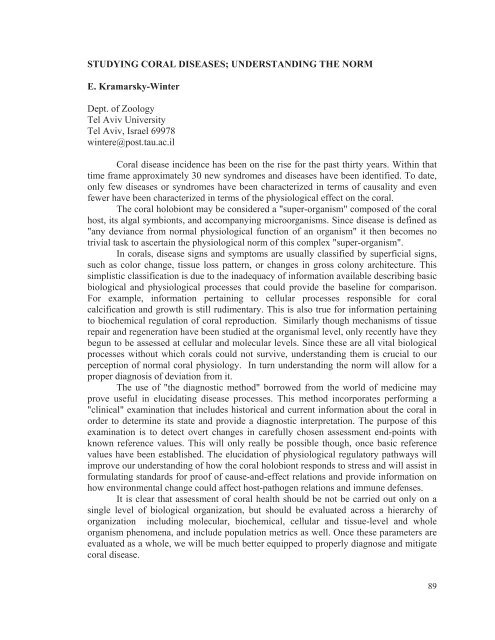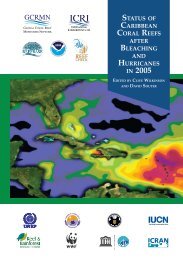Coral Health and Disease in the Pacific: Vision for Action
Coral Health and Disease in the Pacific: Vision for Action
Coral Health and Disease in the Pacific: Vision for Action
Create successful ePaper yourself
Turn your PDF publications into a flip-book with our unique Google optimized e-Paper software.
STUDYING CORAL DISEASES; UNDERSTANDING THE NORME. Kramarsky-W<strong>in</strong>terDept. of ZoologyTel Aviv UniversityTel Aviv, Israel 69978w<strong>in</strong>tere@post.tau.ac.il<strong>Coral</strong> disease <strong>in</strong>cidence has been on <strong>the</strong> rise <strong>for</strong> <strong>the</strong> past thirty years. With<strong>in</strong> thattime frame approximately 30 new syndromes <strong>and</strong> diseases have been identified. To date,only few diseases or syndromes have been characterized <strong>in</strong> terms of causality <strong>and</strong> evenfewer have been characterized <strong>in</strong> terms of <strong>the</strong> physiological effect on <strong>the</strong> coral.The coral holobiont may be considered a "super-organism" composed of <strong>the</strong> coralhost, its algal symbionts, <strong>and</strong> accompany<strong>in</strong>g microorganisms. S<strong>in</strong>ce disease is def<strong>in</strong>ed as"any deviance from normal physiological function of an organism" it <strong>the</strong>n becomes notrivial task to ascerta<strong>in</strong> <strong>the</strong> physiological norm of this complex "super-organism".In corals, disease signs <strong>and</strong> symptoms are usually classified by superficial signs,such as color change, tissue loss pattern, or changes <strong>in</strong> gross colony architecture. Thissimplistic classification is due to <strong>the</strong> <strong>in</strong>adequacy of <strong>in</strong><strong>for</strong>mation available describ<strong>in</strong>g basicbiological <strong>and</strong> physiological processes that could provide <strong>the</strong> basel<strong>in</strong>e <strong>for</strong> comparison.For example, <strong>in</strong><strong>for</strong>mation perta<strong>in</strong><strong>in</strong>g to cellular processes responsible <strong>for</strong> coralcalcification <strong>and</strong> growth is still rudimentary. This is also true <strong>for</strong> <strong>in</strong><strong>for</strong>mation perta<strong>in</strong><strong>in</strong>gto biochemical regulation of coral reproduction. Similarly though mechanisms of tissuerepair <strong>and</strong> regeneration have been studied at <strong>the</strong> organismal level, only recently have <strong>the</strong>ybegun to be assessed at cellular <strong>and</strong> molecular levels. S<strong>in</strong>ce <strong>the</strong>se are all vital biologicalprocesses without which corals could not survive, underst<strong>and</strong><strong>in</strong>g <strong>the</strong>m is crucial to ourperception of normal coral physiology. In turn underst<strong>and</strong><strong>in</strong>g <strong>the</strong> norm will allow <strong>for</strong> aproper diagnosis of deviation from it.The use of "<strong>the</strong> diagnostic method" borrowed from <strong>the</strong> world of medic<strong>in</strong>e mayprove useful <strong>in</strong> elucidat<strong>in</strong>g disease processes. This method <strong>in</strong>corporates per<strong>for</strong>m<strong>in</strong>g a"cl<strong>in</strong>ical" exam<strong>in</strong>ation that <strong>in</strong>cludes historical <strong>and</strong> current <strong>in</strong><strong>for</strong>mation about <strong>the</strong> coral <strong>in</strong>order to determ<strong>in</strong>e its state <strong>and</strong> provide a diagnostic <strong>in</strong>terpretation. The purpose of thisexam<strong>in</strong>ation is to detect overt changes <strong>in</strong> carefully chosen assessment end-po<strong>in</strong>ts withknown reference values. This will only really be possible though, once basic referencevalues have been established. The elucidation of physiological regulatory pathways willimprove our underst<strong>and</strong><strong>in</strong>g of how <strong>the</strong> coral holobiont responds to stress <strong>and</strong> will assist <strong>in</strong><strong>for</strong>mulat<strong>in</strong>g st<strong>and</strong>ards <strong>for</strong> proof of cause-<strong>and</strong>-effect relations <strong>and</strong> provide <strong>in</strong><strong>for</strong>mation onhow environmental change could affect host-pathogen relations <strong>and</strong> immune defenses.It is clear that assessment of coral health should be not be carried out only on as<strong>in</strong>gle level of biological organization, but should be evaluated across a hierarchy o<strong>for</strong>ganization <strong>in</strong>clud<strong>in</strong>g molecular, biochemical, cellular <strong>and</strong> tissue-level <strong>and</strong> wholeorganism phenomena, <strong>and</strong> <strong>in</strong>clude population metrics as well. Once <strong>the</strong>se parameters areevaluated as a whole, we will be much better equipped to properly diagnose <strong>and</strong> mitigatecoral disease.89
















